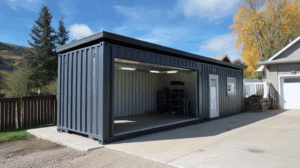The Future of Garage Solutions: Exploring the Benefits of a Shipping Container Conversion
In recent years, shipping container conversions have gained popularity as an innovative solution for various purposes, from housing to office spaces. However, one area where they truly shine is in the realm of garage solutions. Whether you need extra storage space, a workshop, or even a personal gym, a shipping container conversion offers numerous benefits that traditional garages simply can’t match. In this article, we will explore the future of garage solutions by delving into the advantages of a shipping container conversion.
1. Cost-effectiveness
One of the most significant advantages of using a shipping container for your garage is its cost-effectiveness. Compared to building a traditional garage from scratch, converting a shipping container is much more affordable. The initial cost of purchasing a container is considerably lower than constructing a brick-and-mortar garage. Additionally, shipping containers are built to withstand harsh conditions during transportation, making them durable and long-lasting. This means you won’t have to worry about expensive repairs or regular maintenance like you would with a traditional garage.
2. Versatility and Customization
Another benefit of shipping container conversions is their versatility and customization options. These containers come in various sizes and can be easily modified to suit your specific needs. Whether you need a single-car garage or a spacious workshop, there is a container size that can accommodate your requirements. Additionally, the interior of the container can be customized to include shelving, workbenches, and storage solutions tailored to your needs. With a shipping container conversion, you have the freedom to create a garage space that perfectly aligns with your vision.
3. Mobility and Portability
Unlike traditional garages, shipping container conversions offer the advantage of mobility and portability. Containers are designed to be transported easily using trucks or crane equipment, allowing you to move your garage solution wherever you need it. This flexibility can be particularly beneficial if you plan on relocating or if you want to use the garage as a temporary structure. Whether you’re a frequent mover or simply want the option to change the location of your garage in the future, a shipping container conversion provides unparalleled convenience.
4. Eco-Friendly Solution
In an era where sustainability is becoming increasingly important, shipping container conversions present an eco-friendly solution for garage spaces. By repurposing existing containers, you are reducing the demand for new construction materials and minimizing construction waste. Additionally, some companies offer environmentally-friendly modifications, such as installing solar panels or using recycled materials for insulation. By opting for a shipping container conversion, you are making a conscious choice to contribute to a greener future.
5. Security and Durability
Shipping containers are designed to withstand the rigors of international shipping, making them incredibly secure and durable. With their solid steel construction, these containers provide excellent protection for your valuable belongings. They are resistant to extreme weather conditions, fire, and even pests. By converting a shipping container into a garage, you can rest assured that your possessions will be safe and secure.
Conclusion
The future of garage solutions lies in the versatility, affordability, and eco-friendly nature of shipping container conversions. Whether you need extra storage space, a workshop, or any other garage-related solution, a shipping container conversion offers numerous benefits that traditional garages lack. From cost-effectiveness and customization options to mobility and security, these conversions provide an innovative, sustainable, and durable solution for all your garage needs. Embrace the future of garage solutions with a shipping container conversion and experience the countless advantages it has to offer.
The Ultimate DIY Project: Converting a Shipping Container into a Garage
If you’re in need of a garage but want something unique and cost-effective, look no further than converting a shipping container into your very own automotive sanctuary. Not only is this a great way to repurpose a container that would otherwise go to waste, but it also offers a host of benefits, from durability and security to customization options. In this blog post, we’ll guide you through the ultimate DIY project of transforming a shipping container into a fully functional garage.
Why Choose a Shipping Container?
Durability and Security
Shipping containers are built to withstand the harshest conditions, making them incredibly durable and weather-resistant. Constructed with heavy-duty steel, these containers are designed to be stacked and transported across oceans, making them more than capable of protecting your vehicles from the elements. Additionally, their solid construction offers enhanced security, ensuring your prized possessions stay safe and sound.
Cost-Effectiveness
Compared to traditional garage construction, converting a shipping container is a much more budget-friendly option. With containers readily available in various sizes, you have the flexibility to choose one that suits your needs and budget. Moreover, the majority of the structural work is already complete, saving you time and money on building materials.
Customization Possibilities
One of the most exciting aspects of converting a shipping container into a garage is the endless customization possibilities. From insulation and electrical wiring to windows and doors, you have the freedom to design your dream garage according to your specific requirements. Whether you want to include a workshop area, storage space, or even a loft, the versatility of a shipping container allows you to turn your vision into reality.
Steps to Converting a Shipping Container into a Garage
1. Planning and Permits
Before starting your project, it’s essential to check local building regulations and obtain any necessary permits. This will ensure that your garage conversion is compliant with all safety and zoning requirements. Take the time to carefully plan out the layout, considering factors such as vehicle size, workspace requirements, and storage needs.
2. Site Preparation
Prepare the site where you will be placing the shipping container. Ensure the ground is level and stable, as this will provide a solid foundation for your garage. Clear any obstructions and consider adding a gravel or concrete pad to support the weight of the container.
3. Insulation and Ventilation
To make your garage comfortable year-round, insulation is crucial. Apply insulation materials to the interior walls, floor, and ceiling of the container. This will help regulate temperatures and prevent condensation. Additionally, install proper ventilation, such as vents or fans, to ensure adequate airflow within the garage.
4. Electrical and Plumbing
If you plan on using your garage as a workshop or for other purposes, you may need to install electrical outlets, lighting fixtures, and plumbing connections. Consult with a professional electrician or plumber to ensure all wiring and plumbing work is done correctly and safely.
5. Doors and Windows
Choose the type of doors and windows that suit your needs. Roll-up garage doors are a popular choice as they maximize the usable space and provide easy access for vehicles. Windows allow natural light into the garage and can enhance its overall aesthetic appeal.
6. Flooring and Finishing Touches
Select a suitable flooring option for your garage. You can opt for traditional concrete, epoxy coating for a polished look, or even install a raised floor system. Consider adding storage cabinets, workbenches, and other fixtures to optimize the functionality of your garage.
Conclusion
Converting a shipping container into a garage is a rewarding and practical DIY project. By repurposing a container, you not only create a unique space for your vehicles but also contribute to sustainability efforts. The durability, cost-effectiveness, and customization options make it an attractive choice for any DIY enthusiast. So, roll up your sleeves, gather your tools, and get ready to embark on the ultimate DIY adventure of transforming a shipping container into the garage of your dreams.
Unlocking the Potential: Transforming a Shipping Container into a Functional Garage
When it comes to creative and unique solutions for additional space, transforming a shipping container into a functional garage is a trend that is gaining traction. With its sturdy construction, portability, and affordability, a shipping container offers an excellent opportunity to unlock the potential of your property and create a versatile and functional garage space.
Why Choose a Shipping Container?
Shipping containers are designed to withstand harsh conditions during transportation, making them incredibly durable and weather-resistant. Built to last, these containers are made from high-quality steel, offering security and protection for your belongings. Additionally, they are available in various sizes, providing flexibility to suit your specific needs.
The Transformation Process
Transforming a shipping container into a functional garage involves a few key steps. Let’s take a closer look at each one:
1. Selecting the Right Container
Start by choosing the right container size for your garage project. Standard shipping containers come in lengths of 20 or 40 feet, with a width of 8 feet and a height of 8.5 feet. Consider the space you have available and the size of the vehicles or items you plan to store in the garage. If needed, multiple containers can be joined together to create a larger space.
2. Preparing the Site
Before your container arrives, make sure to prepare the site properly. Clear the area of any debris, level the ground, and ensure there is sufficient drainage to prevent water accumulation. It’s also essential to check local building codes and obtain any necessary permits before starting the project.
3. Customizing the Interior
Once the container is in place, it’s time to start customizing the interior to turn it into a functional garage. Begin by insulating the walls and ceiling to regulate temperature and reduce noise. This step is crucial, especially if you plan to use the garage for activities beyond simple storage.
Next, install electrical wiring and lighting fixtures to create a well-lit and functional space. Consider adding windows or skylights to allow natural light in and improve ventilation. You may also want to include shelves, cabinets, and workbenches to maximize storage and workspace.
4. Addressing Security and Accessibility
Security is a top priority when transforming a shipping container into a garage. Install sturdy locks and reinforce doors and windows to ensure the safety of your belongings. For added convenience, consider adding a roll-up garage door or a regular entry door, depending on your needs.
To enhance accessibility, think about adding ramps or steps for easy entry and exit. If you plan to store vehicles, ensure there is enough space for maneuvering within the garage.
The Benefits of a Shipping Container Garage
Transforming a shipping container into a functional garage offers several benefits:
-
Affordability: Compared to traditional garage construction, repurposing a shipping container can be a cost-effective solution. The initial purchase price of a container is typically lower, and the customization options allow you to create a garage tailored to your budget.
-
Portability: Unlike traditional garages, shipping container garages are portable. If you ever need to relocate, you can easily transport your garage to your new property. This flexibility makes shipping container garages a popular choice for renters or those who frequently move.
-
Durability: Shipping containers are designed to withstand extreme weather conditions and provide unmatched durability. Your garage will be resistant to pests, rot, and decay, ensuring long-lasting protection for your vehicles and belongings.
-
Versatility: With a little creativity, a shipping container garage can serve various purposes beyond vehicle storage. It can be transformed into a workshop, home gym, or even an office space. The possibilities are endless.
Unlocking the Potential
Transforming a shipping container into a functional garage is an innovative way to unlock the potential of your property. By repurposing a durable and versatile container, you can create a customized space that fits your specific needs. Whether you’re looking for extra storage, a workshop, or a multipurpose area, a shipping container garage offers affordability, portability, and durability, giving you the freedom to make the most of your space.
Maximizing Space and Creativity: How a Shipping Container can be Transformed into a Garage
In today’s fast-paced world, space is a valuable commodity. Whether you live in a bustling city or a suburban neighborhood, finding ways to maximize the space you have is essential. One innovative solution that has gained popularity in recent years is the transformation of shipping containers into functional living or working spaces. While these versatile structures have been used for various purposes, one particularly exciting transformation is turning a shipping container into a garage.
The Rise of Shipping Container Transformations
Shipping containers have been used for decades to transport goods across the globe. However, due to the surplus of these containers in many ports, they have become an affordable and eco-friendly option for repurposing. Architects and designers have recognized the potential of these sturdy, modular structures and have started transforming them into homes, offices, and even pop-up shops.
The Advantages of a Shipping Container Garage
When it comes to creating a garage space, using a shipping container has several advantages that make it an appealing option:
1. Cost-Effective Solution
Compared to traditional garage construction, repurposing a shipping container can be a cost-effective alternative. The initial cost of purchasing a shipping container is significantly lower than building a garage from scratch. Additionally, the container’s structure is already in place, reducing the need for extensive construction work.
2. Quick and Easy Installation
Shipping containers are designed to be easily transported and installed. Once you have chosen the right container size for your needs, it can be swiftly delivered to your property and placed in the desired location. With minimal modifications, such as adding windows and doors, your container garage can be up and running in no time.
3. Durability and Security
Shipping containers are built to withstand harsh conditions, making them incredibly durable structures. Constructed from sturdy materials like corten steel, they are resistant to rust, fire, and pests. This durability not only protects your vehicles but also ensures the longevity of your garage.
Additionally, shipping containers offer excellent security. With their robust structure and lockable doors, they provide a secure space to store your cars, motorcycles, or any other valuable possessions.
4. Customization Possibilities
One of the most exciting aspects of transforming a shipping container into a garage is the opportunity for customization. These containers can be modified to fit your specific needs and design preferences. Whether you want to add windows for natural light, install insulation for temperature control, or incorporate shelving and storage solutions, the possibilities are endless.
Tips for Transforming a Shipping Container into a Garage
If you are considering transforming a shipping container into a garage, here are a few tips to help you get started:
1. Choose the Right Size
Shipping containers come in various sizes, including 20-foot and 40-foot options. Consider the number and size of vehicles you plan to store in your garage to determine the appropriate container size. It’s also important to check local regulations regarding the maximum size allowed on your property.
2. Plan the Layout
Before diving into the transformation process, carefully plan the layout of your garage. Consider factors such as vehicle access, storage space, and any additional features you may want to incorporate, such as a workbench or tool storage.
3. Insulate and Ventilate
To create a comfortable and temperature-controlled environment, insulation is crucial. Insulating the walls, ceiling, and floor of your container garage will help regulate the temperature and minimize condensation. Additionally, proper ventilation is essential to prevent moisture buildup and maintain air quality.
4. Enhance with Design Elements
Don’t forget to infuse your personal style into the space. Choose a color scheme that reflects your taste and consider adding design elements such as lighting fixtures, flooring options, and wall coverings that complement your vision.
Conclusion
Shipping containers offer an exciting and innovative solution for maximizing space and creativity. Transforming a shipping container into a garage is not only a cost-effective option but also a customizable and durable solution. With careful planning and thoughtful design, your shipping container garage can become a functional and stylish addition to your property. So why settle for a traditional garage when you can explore the endless possibilities of repurposing a shipping container? Get creative and make the most of the space you have!
From Shipping Container to Stylish Garage: A Modern Solution for Urban Living
Living in urban areas often comes with limited space, making it challenging to accommodate all our needs, especially when it comes to storage and parking. Thankfully, innovative solutions have emerged to address these issues while adding a touch of style to urban living. One such solution is transforming shipping containers into stylish garages.
The Rise of Shipping Container Architecture
Shipping containers have gained popularity in recent years as a versatile building material. Originally designed for transporting goods across the globe, these metal boxes have found new life in the realm of architecture. Architects and designers have embraced the concept of repurposing shipping containers as an eco-friendly and cost-effective solution for various structures, including homes, offices, and even retail spaces.
The Advantages of Shipping Container Garages
When it comes to urban living, finding a safe and convenient parking spot can be a real challenge. Building a garage from scratch may not always be feasible due to limited space or budget constraints. This is where shipping container garages offer a fantastic alternative. Here are some advantages to consider:
1. Affordability
Compared to traditional garages, building a shipping container garage can be significantly more cost-effective. The containers themselves are relatively inexpensive, and their modular nature makes them easy to work with. By repurposing a shipping container, you can save on construction costs while still obtaining a functional and stylish garage.
2. Customizability
Shipping containers provide a blank canvas for your creativity. You can easily customize and adapt them to suit your specific needs. Whether you need extra storage space, a workshop, or a place to park your car, a shipping container can be transformed into the perfect garage. With the ability to add windows, doors, insulation, and electricity, you can create a space that meets all your requirements.
3. Durability and Security
Shipping containers are built to withstand harsh environments, making them incredibly durable. Constructed from weather-resistant steel, they can withstand extreme weather conditions and provide a secure space for your vehicle. Additionally, you can enhance their security by adding sturdy locks and reinforced doors, giving you peace of mind knowing that your car is safe and protected.
4. Mobility
While traditional garages are fixed structures, shipping container garages offer a level of mobility. If you ever decide to relocate, you can easily transport your container garage to your new location. This flexibility is particularly useful for urban dwellers who may need to move frequently due to work or other circumstances.
5. Sustainable Living
Repurposing shipping containers for garages aligns with the principles of sustainable living. By giving these containers a second life, you contribute to reducing waste and lowering your carbon footprint. Additionally, shipping container garages can be designed to incorporate eco-friendly features such as rainwater harvesting systems, solar panels, and green roofs, further enhancing their environmental friendliness.
Transforming a Shipping Container into a Stylish Garage
The transformation process of a shipping container into a stylish garage involves several steps:
-
Planning and Design: Begin by envisioning your ideal garage layout and functionality. Consider factors such as the size of the container, the number of vehicles to be parked, and any additional requirements like storage or workspace. Consult with a professional architect or designer to ensure your design meets all safety regulations and building codes.
-
Preparation: Once you have finalized your design, prepare the shipping container for modification. This may involve cleaning, removing any existing fixtures, and reinforcing the structure as needed.
-
Cutting and Framing: Determine the locations for doors, windows, and other openings. Using specialized tools, cut through the steel walls of the container and install framing to support these openings.
-
Insulation and Interior Finishing: To ensure comfort and energy efficiency, insulate the container using suitable materials. Install electrical wiring, plumbing if required, and finish the interior walls with your desired materials, such as drywall or plywood.
-
Exterior Enhancements: Personalize the exterior of your shipping container garage by choosing a color scheme or adding cladding materials. This step not only enhances the aesthetics but also provides additional protection against the elements.
-
Final Touches: Install the doors, windows, and any other fixtures according to your design. Ensure proper ventilation, lighting, and security measures are in place.
Embrace the Future of Urban Living
With the rise of shipping container architecture, the possibilities for stylish and functional urban living have expanded. Converting a shipping container into a garage not only offers practical benefits but also allows you to express your unique style and contribute to a more sustainable future. So, why settle for a conventional garage when you can transform a shipping container into a modern, eco-friendly, and stylish addition to your urban lifestyle?




